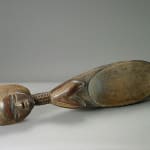Dan Wooden Wunkirmian Ladle, 20th Century CE
Wood
7.5 x 5
PF.6000
Further images
The respect that is accorded women who have attained positions of authority and honor is made visible among the Dan people by the large wooden ladles known as wunkirmian. The...
The respect that is accorded women who have attained positions of authority and honor is made visible among the Dan people by the large wooden ladles known as wunkirmian. The ladles had spiritual power for the women the way masks had power for the men. The spoon bears an idealized portrait of the owner as a young woman at the moment she began her role as mother and wife. The spoons are carved for women who are recognized by other women of the town as the most hospitable persons in a community. The spoons serve as symbol of that status and are used as a kind of dance wand when the honored women dances through the town accompanied by her own entourage of women. At special feasts, she dances with the ladle and directs the distribution of rice to those assembled. An elderly honoree passes the ladle and the honor on to the one she sees fit as a successor.
This ladle is a particularly fine example. Both the smoothly polished woman’s head, perfectly capturing the idealized forms of youthful feminine beauty with her elegantly braided coiffure that framed her face, and the delicately incised patterns that decorate the sides reveals this ladle to be the work of a master carver. Clearly such a gorgeous item, like fine China or silver in our homes, is not to be used daily. Much as we bring out our best China to honor special occasions or important diner guests, this ladle is reserved for ceremonial usage. The beauty of this woman’s visage, like the beauty of the ladle, is immediately evident. Our eyes open wide, tantalized by the stunning artistry of this piece, much like our mouth would be agape anticipating the bountiful nourishment this ladle suggests in it’s memorial to a special woman of the Dan tribe.
This ladle is a particularly fine example. Both the smoothly polished woman’s head, perfectly capturing the idealized forms of youthful feminine beauty with her elegantly braided coiffure that framed her face, and the delicately incised patterns that decorate the sides reveals this ladle to be the work of a master carver. Clearly such a gorgeous item, like fine China or silver in our homes, is not to be used daily. Much as we bring out our best China to honor special occasions or important diner guests, this ladle is reserved for ceremonial usage. The beauty of this woman’s visage, like the beauty of the ladle, is immediately evident. Our eyes open wide, tantalized by the stunning artistry of this piece, much like our mouth would be agape anticipating the bountiful nourishment this ladle suggests in it’s memorial to a special woman of the Dan tribe.





